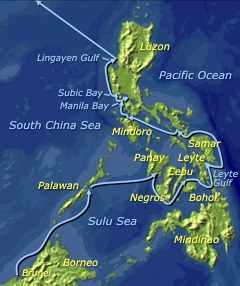
We were well guided by local guides and Valor Tours’ Bob Reynolds, whose name appeared on many historical markers at Corregidor and who delivered shipboard presentations and led excursions at most of the islands visited. Background regarding all aspects of Philippine history, politics, geography and geology was provided by Lea Williams and a World War II perspective was provided by Dave McComb.

Track of Clipper Odyssey in the Philippines, 6–20 April 2007.
The ship’s itinerary and local restrictions prevented daytime passage through bodies of water associated with the 1944 Battle for Leyte Gulf—the Sibuyan Sea, San Bernardino Strait, Surigao Strait and the Pacific Ocean off Samar—although in all cases these were transited on clear, moonlit nights that provided an opportunity for the experience of them if not photography.
Outstanding from a World War II historical perspective were landings:
In addition to Leyte and Luzon, American forces conducted 38 other landings in the Philippines and Borneo in 1945. Thus, nearly every stop has some association with World War II, though only locations at Leyte and Luzon offered photographic opportunities closely associated with World War II action while those at Leyte Gulf’s San Pedro Bay and Luzon’s Subic Bay recalled at life at those major bases from 1945.
Popular ports of call included Donsol in Luzon’s Bicol region and scenic Puerto Galera on Mindoro’s north coast, a full day in Manila and two days spent retracing the route of the Bataan death march from Mariveles to Cabanatuan, where the last living prisoners were rescued in the great raid of 1945. Initial stops were made at Palawan, Panay and Cebu.